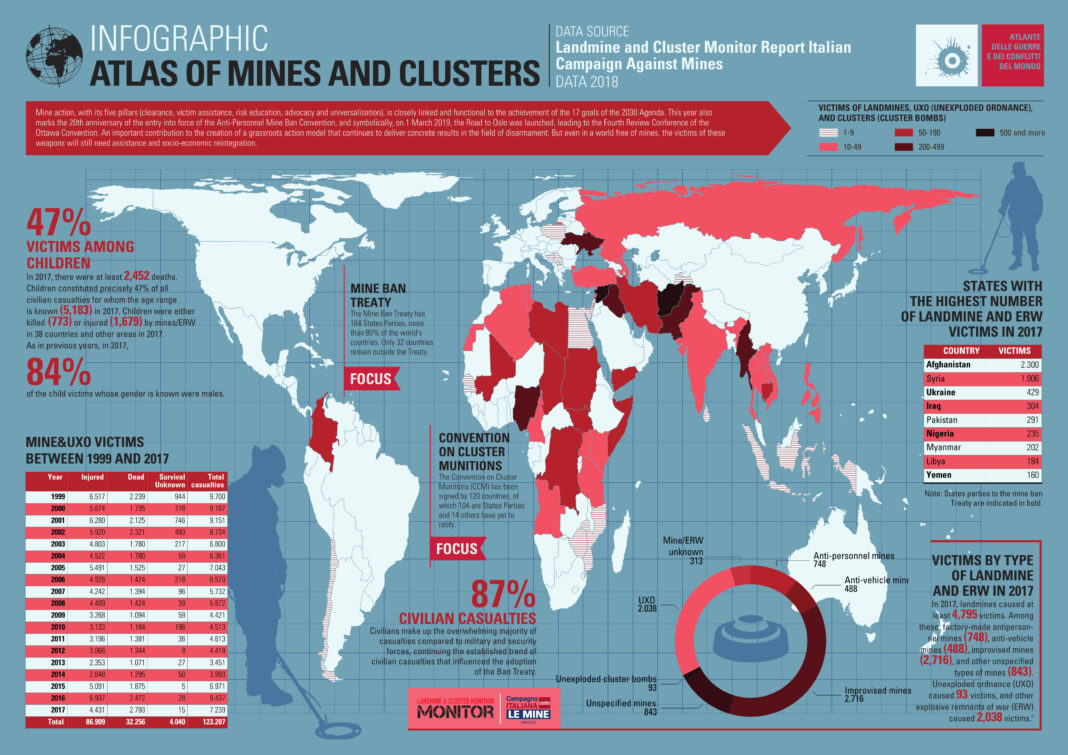The 25th edition of the Landmine Monitor, the annual monitoring report of the International Campaign to Ban Landmines (ICBL-CMC), was launched in Geneva on 14 November. The report provides a global overview of the international anti-personnel landmine situation and assesses the actions of the international community to advance the Mine Ban Treaty. The Monitor reports an increase in casualties due to new anti-personnel mine use in 2022.
According to the report, 4,710 people were injured or killed by anti-personnel mines or explosive remnants of war (ERW) in 49 States and two other areas during the year. Civilians accounted for 85% of all mine and ERW casualties recorded in 2022, half of them children (1,171). The highest numbers of annual casualties were recorded in Syria (834) and Ukraine (608). The conflict in Ukraine saw a tenfold increase in civilian casualties from APMs and ERW (58) compared to 2021. This was followed by Yemen (State Party) and Myanmar (non-State Party), each of which recorded more than 500 casualties.
The Monitor reports the use of these banned devices by Myanmar and Russia in 2022 and the first half of 2023. Russia has been using anti-personnel mines extensively in Ukraine since February 2022. Ukrainian authorities are investigating the circumstances surrounding the use of anti-personnel mines by their forces in and around the town of Izium, in the Kharkiv oblast, in 2022, when the town was under Russian control.
According to Landmine Monitor data, 2023 anti-personnel mines were used by non-state armed groups in Colombia, India, Myanmar, Thailand and Tunisia, and in eight States Parties in the Sahel region – Algeria, Benin, Burkina Faso, DRC, Mali, Niger, Nigeria and Togo. According to the report, there are 60 countries contaminated by anti-personnel mines and other areas. Of these, 33 are States Parties with mine clearance obligations under Article 5 of the Mine Ban Treaty. 22 are States not Party and five are other areas. Afghanistan, Bosnia and Herzegovina (BiH), Cambodia, Croatia, Ethiopia, Iraq, Turkey and Ukraine are the States with the highest levels of contamination, with more than 100 km² of contaminated areas reported in 2022. In Ukraine, the ongoing conflict is exacerbating existing contamination. A total of 30 States Parties have reported that they have cleared all mined areas on their territory since the Mine Ban Treaty entered into force in 1999.
Despite the increase in casualties, health and physical rehabilitation services for victims remain underfunded. International support for victim assistance totalled $37.6 million, a 47% increase over the previous year. However, this represented only 5% of total mine action funding. Half of all victim assistance went to three countries: Afghanistan, Syria and Yemen. Global mine action assistance totalled $913.5 million, an increase of 52% ($314.5 million) over the assistance provided in 2021. Of this amount, $162.3 million was allocated to activities in Ukraine. The United States and the European Union, the two largest donors, significantly increased their annual contributions in 2022.
“We are called upon as civil society to ensure that the international community is committed to protecting the Mine Ban Treaty from the various assaults it faces between new uses of these devices, countries like Armenia being added to the list of producers, and insufficient funds to cope with the many activities needed to restore a safe and dignified life to people living in contaminated countries,” says Giuseppe Schiavello, Director of the Italian Campaign to Ban Landmines. “We endorse”, concludes Schiavello, “the call made by the UN Secretary-General in his ‘New Agenda for Peace’, in which he urges all UN member states to work towards the universalisation of treaties banning inhumane and indiscriminate weapons, including the Mine Ban Treaty, instruments which, together with the Geneva Convention, are necessary to save the lives of civilians caught up in conflicts”.























